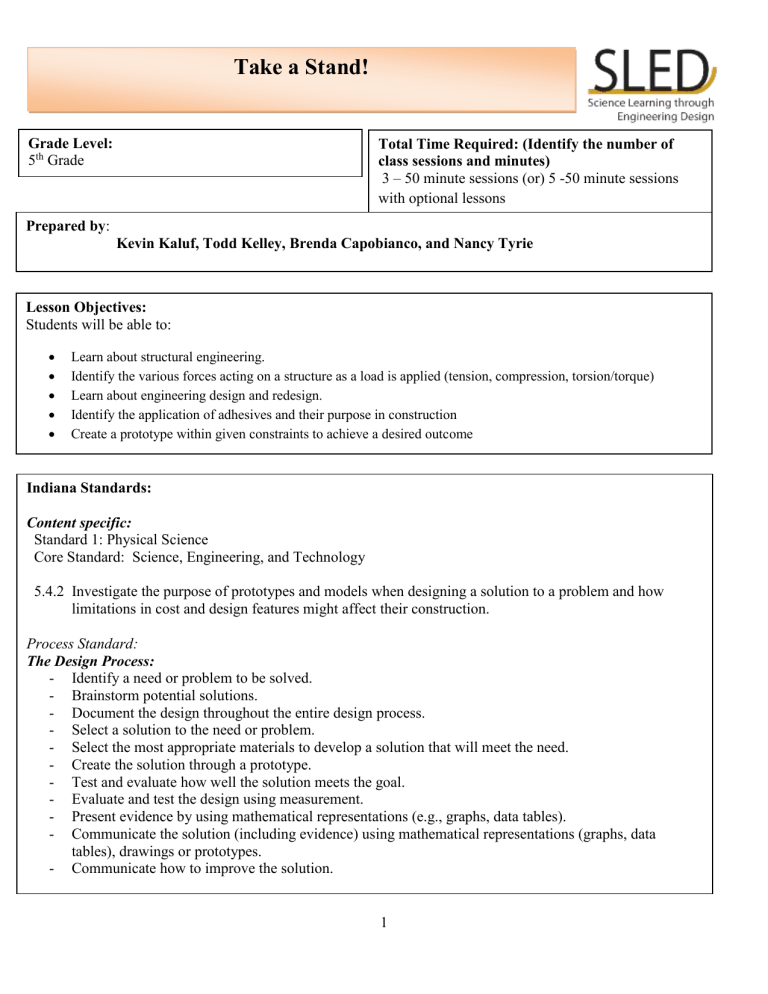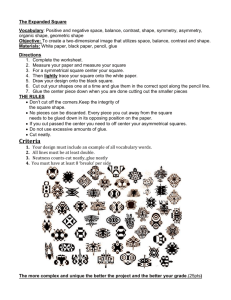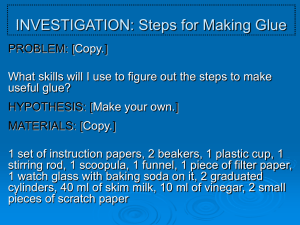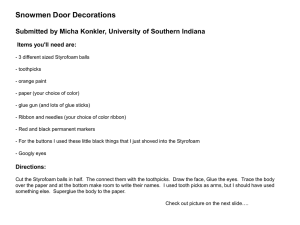Take_a_Stand__Lesson_Plan

Take a Stand!
Grade Level:
5 th
Grade
Total Time Required: (Identify the number of class sessions and minutes)
3 – 50 minute sessions (or) 5 -50 minute sessions with optional lessons
Prepared by :
3
Kevin Kaluf, Todd Kelley, Brenda Capobianco, and Nancy Tyrie
Lesson Objectives:
Students will be able to:
Learn about structural engineering.
Identify the various forces acting on a structure as a load is applied (tension, compression, torsion/torque)
Learn about engineering design and redesign.
Identify the application of adhesives and their purpose in construction
Create a prototype within given constraints to achieve a desired outcome
Indiana Standards:
Content specific:
Standard 1: Physical Science
Core Standard: Science, Engineering, and Technology
5.4.2 Investigate the purpose of prototypes and models when designing a solution to a problem and how limitations in cost and design features might affect their construction.
Process Standard:
The Design Process:
Identify a need or problem to be solved.
-
Brainstorm potential solutions.
Document the design throughout the entire design process.
-
Select a solution to the need or problem.
Select the most appropriate materials to develop a solution that will meet the need.
Create the solution through a prototype.
Test and evaluate how well the solution meets the goal.
Evaluate and test the design using measurement.
Present evidence by using mathematical representations (e.g., graphs, data tables).
Communicate the solution (including evidence) using mathematical representations (graphs, data tables), drawings or prototypes.
Communicate how to improve the solution.
1
Concepts and Vocabulary
Science Concepts / Vocabulary:
Term
Adhesive
Compression
Load
Tension
Torsion
Torque
Defined by a scientist or engineer Defined by a 5
A substance used for sticking objects or materials together Glue, tape th
grade student
A force that squeezes a material together Pushing force
A mass or weight supported by something
A force that stretches a material apart
An action that twists a material
The tendency of a force to rotate an object about an axis, fulcrum, or pivot
Weight
Pulling force
?
?
Equipment, Materials and Tools
List the quantities of all materials and equipment needed:
Tools
Scissors
Rulers
Materials popsicle sticks (20/ team)
Paper clips
Variety of glues
Design Brief
Wax paper
Newspaper
Variety of different balls- baseball, softball, shot put
Paper towel
Binder Clips
Small Post-it notes
Sketching Paper
Special Materials, Notes and Comments
Safety concerns – It is not recommended to use Super Glue or Crazy Glue adhesive, rubber cement, or other hazardous adhesives!
2
Information about tension: In physics, tension is the magnitude of the pulling force exerted on another object. It is the opposite of compression. http://www.pbs.org/wgbh/buildingbig/lab/forces.html
Information about compression: In physics, compression is the magnitude of the pushing force exerted on another object. It is the opposite of tension. http://www.pbs.org/wgbh/buildingbig/lab/forces.html
Information about torsion: In physics, torsion is the twisting of an object due to an applied torque .
Torque is the tendency of a force to rotate an object about an axis, fulcrum, or pivot. Just as a force is a push or a pull, a torque can be thought of as a twist. http://www.pbs.org/wgbh/buildingbig/lab/forces.html
3
Lesson Plan #1
Guiding Question – Which glue provides the greatest strength?
Time: 2- 30 minute sessions (Note: glue must dry after first 30 minute session)
Procedures / Steps:
1. Select design teams by breaking the class into teams of 2-3 students, distribute materials to each group.
2. Present design briefs to the design teams. Explain that the challenge is to create a structure to hold various size sports balls including a shot put. The structure must hold the various balls 2” off a display case shelf. The design teams’ first task is to determine what adhesive is best to use for this structure.
3. Design teams will meet and develop a team plan for testing the strength of the chosen adhesive. Students must form a testable question about the adhesive and determine how the materials will be tested. The final plan will need to be recorded in their design journals indicating specific procedures for running the investigation. Testing several different types of glue should be encouraged.
4. Design teams next execute their investigation plans. Time will be needed for the glues to dry completely, 24 hours if time allows.
5. After the glue has completely dried, the design teams can execute their tests on the glue bonds.
Each design team should evaluate their results and indicate which glue was most successful.
Encourage students to use a Likert scale to summarize their results when testing multiple glues
(such as 4 = most effective, 3 = good, 2 = fair. 1 = poor). The results of the investigation should be recorded in the design journals and the overall findings will be presented to the class.
6. For an extra challenge, have student design teams add the task of making their own glue (see
Lesson Plan #2), and have the design teams decide whether their glue or factory-made glues work better, and why this might be so
.
4
Lesson Plan #2 (Optional)
How can we make our own adhesive?
Time: 45-50 Minutes
Procedures / Steps:
For an optional activity, you may wish to have the design teams create their own glues to use on their structures. Some of these recipes would require the use of a stove or hot plate and would require adequate adult supervision and extra safety precautions.
Glue Recipe 1 (no heat source)
Mix 1/2 cup of flour with 1/4 cup of water.
Glue Recipe 2 (no heat source)
Mix 2 cups flour with one 1 cup of cold water and 1 cup of hot tap water
Glue Recipe 3 (requires heat source)
1. Mix in a saucepan: 1 cup flour, 1 cup sugar, 1 tsp. alum, 4 cups water
2. Cook until clear and thick. Add 30 drops oil of cloves or wintergreen (etc.) and store covered.
Glue Recipe 4 (requires heat source)
1. Mix 3/4 cup water, 3 tablespoons sugar, and 1 teaspoon white vinegar in small saucepan. Bring to a rolling boil.
2. In a separate bowl, mix 1/2 cup cornstarch or corn flour and 3/4 cup water, mix over a very low heat.
3. Add cornstarch mixture slowly to water/sugar/vinegar mixture. Stir continually for two minutes.
4. Take off heat and let cool completely before using as glue
Reference: http://www.tryengineering.com/lessons/stickyengineering.pdf
5
Lesson Plan #3
Design Challenge – Designing a structure to hold a shot put
Time: (2) 45 minutes (build time+ drying time) and Testing
Procedures / Steps:
1. Return to their design teams and review their results of glue testing and the results of other teams’ testing results. Select the best glue for the task.
2. Review the design briefs with the class, highlighting the constraints of the design challenge.
Have each team member design their own solution to the design challenge. After students have had time to create their own designs, have them share their plans with the team. The design teams should discuss and select the best design for implementation. All team members should create a final team design sketch in their design journal.
3. Gather materials and tools needed for construction of the structure. Remind students that they cannot use any more than 20 popsicle sticks and only one type of glue. Newspaper or wax paper should be placed on the desks for keeping work surfaces clean. Various size binder clips make excellent clamps for holding pieces together. Gluing may need to take place in stages, allowing some parts of the structure to partially dry- this takes some managing.
4. Any modifications that have been made to their structure during the building phase should be noted in students design notebooks.
5. (Optional) Have the design teams use post-it notes with codes to indicate where they believe the load will apply forces in tension (TN), compression (CM), and torsion (TR) on the structure.
This is an excellent time to review forces acting on a structure. The Building Big website by
PBS is an excellent resource and includes a forces lab: www.pbs.org/wgbh/buildingbig/lab/forces.html
Simple Post and Beam
For a simple post and beam design, the horizontal wooden beam is in compression at the top of the beam and tension at the bottom. The vertical beams that support the horizontal beam are both in compression. Image from www.explainthatstuff.com.
Load
6
Truss Design
For a truss design, the forces acting on the structure are more complex. Trusses use triangulation
(structures using triangles) so the compression and tension forces occur at different structure members. See image below. For more information visit: http://www.nirimbatafe.com/subjects/buildright_toolbox/content/bcgbc4010a/04_struct_members/03_wind_b racing/page_005.htm
Loaded Truss Example:
Structure has members in compression, tension, or no force.
CM
Load
0
CM
Load
0
CM
TN = Tension
CM = Compression
0 = No Force
If the load is offcenter, that is when often
TN TN torsion occurs.
6. Have each design team present their prototypes to the class. Each team must identify where they think the forces will act on the structure and explain their rationale.
7. Begin testing each team’s design. Allow one team member from each group to place the various balls on the display stand prototype beginning with the baseball, then a softball, and finally a shot put.
8. Each team will record their observations and final results of the prototype testing. Students should be encouraged to note specifically where structural failure occurred and possible reason for the failure.
7
Lesson Plan #4
Design Challenge – What feedback did you get on your design?
Time: (2) 45 minutes (build time+ drying time) and Testing
Procedures / Steps:
1.
Now that the students have tested their structures, how could they redesign it? Have student design teams look at their design journals and note their observations from the previous lesson. They should be looking at: a) What went well?; b) What parts of the structure failed?; and c) What improvements can be made in a modification? These new redesign ideas should be noted and designed in the students’ design journals.
2.
If time permits - Teachers should go back to Step #3 of Lesson Plan #3 and have student design teams build new structures based on their discussions and redesigns in their design journals.
Assessment
The following are possible sources of formative and summative assessment:
Design notebooks (individual) – Note how students identify and clearly label their drawings; Identify the types of science vocabulary students use in their notebooks (tally the number of times each concept is used); Note how students record data from testing their prototypes and how well they explain their results (patterns in the data).
Participation (group) – Note level of engagement; questions students asked; how well they worked in a group; how well each team met the goals of the task
Other (individual) implement the pre and posttest that highlight key science vocabulary terms.
8
Activity Extensions:
Lesson Extensions and Resources
Web Resources: http://www.pbs.org/wgbh/buildingbig/index.html http://www.pbs.org/wgbh/buildingbig/lab/forces.html http://www.tryengineering.com/lesson_detail.php?lesson=25 http://www.explainthatstuff.com/howbuildingswork.html
http://www.nirimbatafe.com/subjects/buildright_toolbox/content/bcgbc4010a/04_struct_member s/03_wind_bracing/page_005.htm
Other Resources:
Videos Building Big: Bridges/Domes/Skyscrapers/Dams/Tunnels to order - http://www.amazon.com/Building-Big-Bridges-Skyscrapers-Tunnels
/dp/B0002XVS92/ref=sr_1_1?s=movies-tv&ie=UTF8&qid=1316702894&sr=1-1
Books Building Big by David Macaulay (2000) ISBN# 978-0395963319
The Art of Construction: Projects and Principles for Beginning Engineers & Architects by Mario
Salvadori (2000) ISBN# 978-1556520808
9
Design Activity – Take a Stand!
Student Resource
Your High School has created a new display case to celebrate a 100 years in
High School Sports.
Your 5 th grade class has been chosen to design displays for vintage baseballs, softballs, and shot puts. Display stands must be designed to hold these various size balls. The stand must be strong and attractive. The best design will be used in the new display case and include a special plaque with the design team members names.
Can your design team create the winning design?
Your Task:
Design and test a structure to hold a shot put at least two inches above a surface.
Your structure should:
Use 20 or less popsicle sticks
Use only one type of glue chosen from your investigation results
Hold the balls 2”(inches) above the surface of a desk for 20 seconds
Be an attractive design for the display case
Note: The tie breaker is the team that holds the shot put for the required time and uses the least amount of popsicle sticks.
10






